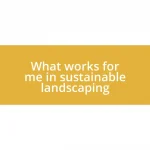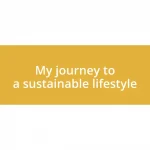Key takeaways:
- Community-led design projects prioritize local voices, fostering creativity and collaboration among participants.
- Key benefits include enhanced social connections, increased creativity through diverse input, and a strong sense of community ownership.
- Essential principles for engagement involve building trust, fostering inclusivity, and celebrating successes to maintain enthusiasm.
- Challenges such as managing conflicting interests, volunteer burnout, and resource limitations require innovative solutions and sustained motivation.

Overview of community-led design projects
Community-led design projects embody a unique approach, where the voices of local residents are at the forefront of the creation process. I remember working on a community garden initiative; the excitement on residents’ faces as they shared their ideas was truly infectious. It’s fascinating how these projects can transform not just physical spaces, but also foster a sense of belonging among participants.
In my experience, these projects often thrive on collaboration and mutual respect. When I see neighbors coming together to brainstorm solutions, it’s this synergy that sparks creativity. Have you ever been part of a group that tackled a common challenge? There’s an energy in those brainstorming sessions that often leads to unexpected and innovative outcomes.
Moreover, the impact of community-led design extends to empowering individuals. People who feel heard are more likely to engage and take ownership of their environment. I recall a project where local artists contributed murals to a park transformation, which not only beautified the space but also gave rise to a newfound pride in the community. Isn’t it amazing how design can evoke such powerful emotions and connections?

Benefits of community involvement
Community involvement in design projects brings a myriad of benefits that often go beyond the surface. From my perspective, one of the most significant advantages is the enhancement of social connections. I distinctly remember participating in a local park revitalization project. As people from diverse backgrounds collaborated, I witnessed new friendships forming right before my eyes. It was heartwarming to see individuals who had previously only exchanged polite nods becoming true allies, united by a common goal.
The creativity that springs from community-driven efforts is truly remarkable. Whenever I find myself in the midst of a brainstorming session, I relish the diverse ideas swirling around the room. Each person brings unique insights based on their lived experiences. I recall a time when a group of elderly residents suggested using native plants for a sustainable garden project. Their deep-rooted knowledge enriched our plans, leading to an outcome that celebrated both creativity and ecological responsibility.
Furthermore, the empowerment that comes from community involvement cannot be understated. When locals take part in designing their spaces, they gain a sense of ownership. I remember leading a workshop where residents shared their visions for a neighborhood arts festival. Their excitement to contribute their thoughts was palpable. In that moment, I realized it wasn’t just about the festival; it was about fostering a sense of pride and agency among participants. Nothing compares to the feeling of seeing your ideas come to life, does it?
| Benefits | Examples |
|---|---|
| Enhanced social connections | New friendships formed during collaboration |
| Increased creativity | Diverse ideas from varied backgrounds |
| Empowerment | Ownership of designs leads to community pride |

Key principles of community engagement
Community engagement is not just about gathering opinions; it’s a thoughtful process rooted in key principles that nurture collaboration. I’ve seen firsthand how establishing trust is essential. In a neighborhood project aimed at repurposing an old school building, we hosted a series of open forums. The genuine enthusiasm from attendees, sharing their visions and concerns, truly made a difference. It felt more like a gathering of friends rather than a mere meeting, fostering an atmosphere where everyone felt comfortable contributing.
Here are some key principles to consider:
- Build Trust: Establishing honest relationships encourages open communication.
- Foster Inclusivity: Engage diverse groups to ensure all voices are heard, enriching the dialogue.
- Encourage Participation: Create opportunities for all community members to contribute actively.
- Provide Feedback: Acknowledge contributions and share how input was integrated into the design process.
- Celebrate Success: Recognizing and celebrating milestones helps maintain enthusiasm and commitment.
Reflecting on my own experiences, every time we celebrated small wins, like designing the community mural, it reignited excitement and deepened our sense of connection. Those celebrations weren’t just about the art; they were about recognizing the collaborative spirit that made it all possible.

Tools for effective collaboration
When it comes to tools for effective collaboration, digital platforms have become indispensable. I remember the first time I introduced a project management tool to my team. Suddenly, our scattered ideas found a home, and each member could see their contributions materializing in real-time. It felt empowering to have everything organized, and I saw how much more engaged everyone became as a result.
In addition to digital tools, I’ve found that traditional methods, like sticky notes and whiteboards, still hold immense value. During a community workshop aimed at redesigning a local square, I used these tools to encourage brainstorming. Watching participants jot down their ideas, and then clustering them into themes, sparked a lively discussion. Who would have thought that something so simple could ignite such passion? There’s something about physically moving notes around that brings ideas to life and fosters a sense of ownership.
Moreover, communication tools play a critical role in keeping everyone connected. I vividly recall a design charrette where we utilized a group messaging app. The dynamic conversations that unfolded outside of our formal meetings really drew people in. It was like a virtual watercooler moment—ideas blossomed spontaneously, and newcomers felt invited to contribute, breaking down barriers and enhancing our collaborative energy. Isn’t it fascinating how the right tools can turn a group of individuals into a cohesive team?

Case studies of successful projects
Reflecting on a notable community-led project in my neighborhood, I was part of revitalizing a neglected park. We gathered to clean up debris, paint benches, and plant flowers, all of which were driven by ideas from local residents. I remember feeling a rush of pride as we collectively viewed our handiwork; it wasn’t just a park anymore—it was a symbol of our joint efforts and resilience. Seeing families return to enjoy the space reaffirmed that our hard work had paid off, creating a feeling of ownership and pride.
Another inspiring example involves a community center dedicated to cultural arts. The process of its redesign was nothing short of magical. We organized working groups to brainstorm ideas, and I vividly remember one session where an elderly gentleman shared stories of the center’s history. His tale sparked infectious enthusiasm, and in no time, we were sketching ideas that incorporated his memories into the design. It struck me how these personal narratives could guide our path forward, emphasizing that community spaces are deeply rooted in their stories and cultural significance.
One standout case that always resonates with me is a community garden initiative. Volunteers of all ages came together, sharing knowledge from urban farming to composting techniques. I was there on the inaugural planting day, surrounded by laughter and a palpable sense of shared purpose. The moment we harvested our first tomatoes, I experienced an overwhelming sense of joy—not just because of the food itself, but for what it represented: a collaborative success. It made me ponder, what might we achieve when we harness our collective strengths?

Challenges in community-led design projects
In my experience, one major challenge of community-led design projects is managing diverse opinions and conflicting interests. I remember a project where we aimed to design a neighborhood park, and the discussions became quite heated. Some residents wanted a playground, while others stressed the importance of green space for community gatherings. It was like trying to herd cats! Balancing everyone’s needs while ensuring the project moved forward felt daunting. Have you ever found yourself in a situation where you had to compromise? Those moments are tough but can lead to surprising breakthroughs when everyone feels heard.
Another challenge is the potential for burnout among community members. In one initiative I participated in, we were all fired up at the start, but as weeks turned into months, enthusiasm waned. I recall sitting in a meeting where fatigue literally hung in the air. Some volunteers began to drift away, replaced by new faces who brought fresh energy but weren’t as deeply connected to the project’s vision. This cycle made me realize that sustaining motivation is crucial for long-term success. How can we keep the flame alive? Incorporating regular check-ins and celebrating small wins can help refocus our collective energy.
Resource limitations often pose another obstacle in these projects. During a local festival I helped organize, we were thrilled but quickly realized our budget didn’t stretch as far as we’d hoped. I vividly remember the late-night brainstorming sessions over pizza, trying to salvage the event with creative, low-cost solutions. It was amazing how necessity sparked innovation! However, this experience taught me that planning for potential constraints from the outset could save a lot of stress down the line. Have you ever had to think outside the box to get something done? Those tough moments often lead to the most memorable solutions.












